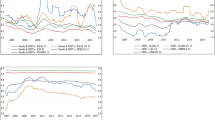Abstract
Numerous studies in the finance literature have investigated technical analysis to determine its validity as an investment tool. This study is an attempt to explore whether some forms of technical analysis can predict stock price movement and make excess profits based on certain trading rules in markets with different efficiency level. To avoid using arbitrarily selected 26 trading rules as did by Brock, Lakonishok and LeBaron (1992) and later by Bessembinder and Chan (1998), this paper examines predictive power and profitability of simple trading rules by expanding their universe of 26 rules to 412 rules. In order to find out the relationship between market efficiency and excess return by applying trading rules, we examine excess return over periods in U.S. markets and also compare the excess returns between U.S. market and Chinese markets. Our results found that there is no evidence at all supporting technical forecast power by these trading rules in U.S. equity index after 1975. During the 1990s break-even costs turned to be negative, –0.06%, even failing to beat a buy-holding strategyin U.S. equity market. In comparison, our results provide support for the technical strategies even in the presence of trading cost in Chinese stock markets.
Similar content being viewed by others
References
Beechey, M., Gruen, D., and Vickery, J. (2000) The efficiency market hypothesis: A survey, Research Discussion Paper, Reserve Bank of Australia.
Bessembinder. H. and Chan, K. (1995) The profitability of technical trading rules in the Asian stock markets, Pacific-Basin Finance J. (July), 257–284.
Blume, L., Easley, D., and O'Hara, M. (1994) Market statistics and technical analysis: The rule of volume, J. Finance (Marebi), 53–181.
Brock, V., Lakonishok, J., and LeBaron, B. (1992) Simple technical trading rules and the stochastic properties of stock returns, J. Finance (December), 1731–1764.
Fama, E. and French, K. (1988) Dividend yields and expected stock returns, J. Financ. Econom. (October), 3–26.
Fama, F. and Blurne, N. I. (1966) Filter rules and stock market trading profits, J. Busin. (April), 226–241.
Jensen. M. and Benington, G. (1970) Random walks and technical theories. Some additional evidence, J. Finance (June), 469–282.
New York Times (2000) Mar 19, New York.
Ruggiero, M. Jr. (2001) New age trading systems for dynamic markets. In Futures, Cedar Falls, Jun 2001, 54–56.
Sullivan, R., Timmermann, A., and White, H. (1999) Data-snooping, technical trading rule performance, and the bootstrap, J. Finance 54(5), 1647–1691.
Author information
Authors and Affiliations
Rights and permissions
About this article
Cite this article
Tian, G.G., Wan, G.H. & Guo, M. Market Efficiency and the Returns to Simple Technical Trading Rules: New Evidence from U.S. Equity Market and Chinese Equity Markets. Asia-Pacific Financial Markets 9, 241–258 (2002). https://doi.org/10.1023/A:1024181515265
Issue Date:
DOI: https://doi.org/10.1023/A:1024181515265




